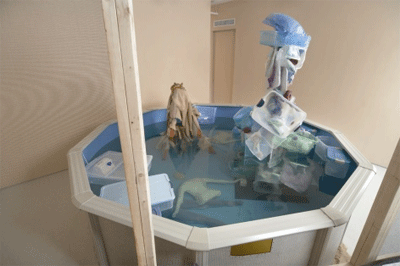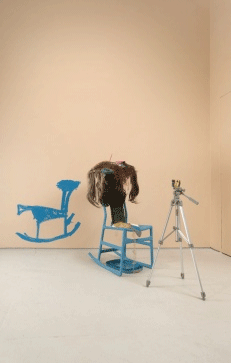
Few things are farther from the cool white walls of Chelsea than the anxieties and values of teenage suburbia, which is probably why Ryan Trecartin’s videos about them, untranslated into the art world’s dominant dialect of aloof criticality, looked so exotic and aroused so much excitement when he made his gallery debut here a year and a half ago. Trecartin’s work grows out of YouTube rants, Myspace intros, and other random homemade shorts , and while grotesque histrionics set his videos apart from the average upload, he keeps them close to their sources of inspiration by addressing issues of popularity, independence, and social approval, and shooting them in spacious beige interiors that approximate the bedroom of the regular webcam-wielding kid. Lizzie Fitch, who has collaborated with Trecartin on his videos as an actress and set designer, makes installations based on the same bland domestic environment, using furniture and appliances from big-box stores. Trecartin and Fitch’s current video-free exhibition at Elizabeth Dee, the first time they’ve had a double billing at the New York gallery, lies closer to Fitch’s territory than Trecartin’s, and the calculated result doesn’t indicate a promising direction for either artist to take.
Trecartin and Fitch use the gallery’s two rooms to simulate the interior and exterior of a suburban home, but they’ve switched the order of the front and back so that the viewer becomes an intruder, passing through the backyard before entering the living room. The first installation, The Aboutthing (in the air), suggests a good time that ended in disaster. Rubbermaid boxes bobbing in an above-ground pool-- a lowbrow luxury, not as fancy as an inground pool -- contain the residue of a deck party: a working stereo and empty cans of Red Bull. Pieces of dummies and mannequins float in the water or lie at the bottom, like drowning victims. On the “inside,” amid ladders and clusters of unpacked luggage, deformed mannequins are posed in front of the lenses of mass-market photo and video equipment. These heavy-handed allusions to the self-documentation that inspires Trecartin’s videos have variations in a few sight gags about representation: there’s an opaque window painted on one wall, and a slapdash rendering of a blue chair on another, next to an actual blue chair. But the humor comes off as studied and strained. The presence of the unused recording equipment adds up to an admission that video is missing, and that neither of these artists are entirely comfortable building a stage set that they’re not going to perform in.

Theatricality without theater is common in installation art, and often done well. But these particular piles of distressed consumer goods would benefit from text and action. Performance is a way for Trecartin and friends to put themselves on the same level as the regular teenage webcam user, and that’s what makes his videos feel fresh. By displacing live actors with dummies, Trecartin and Fitch remove themselves from youthful hysteria and assume the same old detached gaze so pervasive in contemporary art.

